Part of the Series
Planet or Profit
We are in the midst of an era of frightening contradictions, when it comes to public understandings of climate change. While climate changes are occurring more quickly than scientists have ever predicted, most people’s knowledge of these realities remains hazy and clouded by political overtones. Because of both the counter-intuitive nature of climate change and the massive misinformation campaigns created by the fossil fuel industry, the general population is 20 years behind most climate scientists when it comes to the straightforward fact of “believing in” climate change. This is an ominous statistic: Now that scientists are predicting that even worse impacts than previously understood will happen significantly sooner, a rapid global response will be necessary for any attempt to stave them off. We are likely closer to irreversible dangerous climate change – if it has not begun already – and to take action, there must be a basic public consensus. There is, however, some hopeful news on the technological front if action is taken soon.
In 1976, Wallace Broeker was one of the first to suggest climate change could alter our planet harmfully within our lifetimes. Even though a few scientists said in the ’70s we could be headed for an ice age, Broeker had already made the connection, and those few climate scientists have not talked about a coming ice age in nearly 40 years. Broeker is arguably the grandfather of climate science: He’s been at it for 55 years.
One of his first jobs was under Willard Libby, who was awarded the Nobel Prize in 1949 for discovering carbon-14 dating. This rare but predictable form of carbon is radioactive, and it completely decays in about 55,000 years. It is because of carbon-14 dating that we know for absolutely certain that the extra carbon dioxide in our atmosphere came from burning fossil fuels.
There are many other ways that we know for sure. The physics of the greenhouse effect are easily demonstrated in the lab, and even the simplest models from the early 1980s prove their effect. Surprisingly, the complicated high resolution climate models of today yield results that are quite similar to those of the simplest models of the early 1980s.
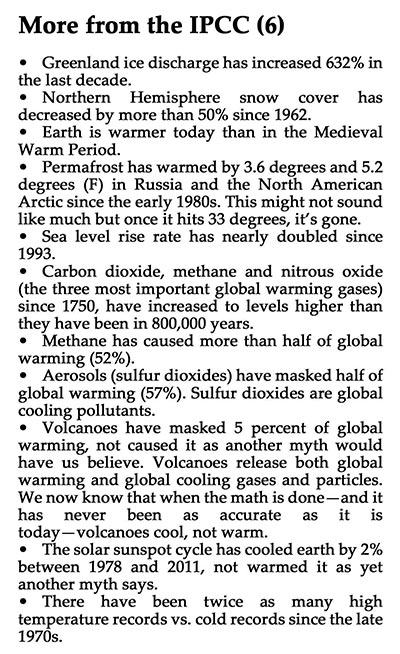 But how are we supposed to trust the models when weather people can’t even get the seven-day forecast correct? Weather models predict what you need to wear to work or school this week. They are built out of the most recent weather data, and by the time they run off five or six days into the future, they are often wrong.
But how are we supposed to trust the models when weather people can’t even get the seven-day forecast correct? Weather models predict what you need to wear to work or school this week. They are built out of the most recent weather data, and by the time they run off five or six days into the future, they are often wrong.
One can load a climate model up with any old weather data; this week’s, last month’s or last year’s. It doesn’t matter where the models start in time. Climate scientists create scores and hundreds of model runs and then average all of those wrong forecasts together to get average weather. Average weather is climate. Climate is not the seven-day forecast. The chaos that makes weather models wrong so quickly is actually what makes climate modeling work so well.
Intergovernmental Panel on Climate Change 2013
Climate measurements continue to become both more precise and more reliable – and thus, more terrifying. A new report by the Intergovernmental Panel on Climate Change (IPCC), which combines the work of 2,000 scientists from 154 countries, drawing from millions of observations from more than 9,000 scientific publications, confirms and strengthens previous predictions and adds one new and very important observation. Even 100 percent emissions reductions will no longer keep our climate from changing dangerously.
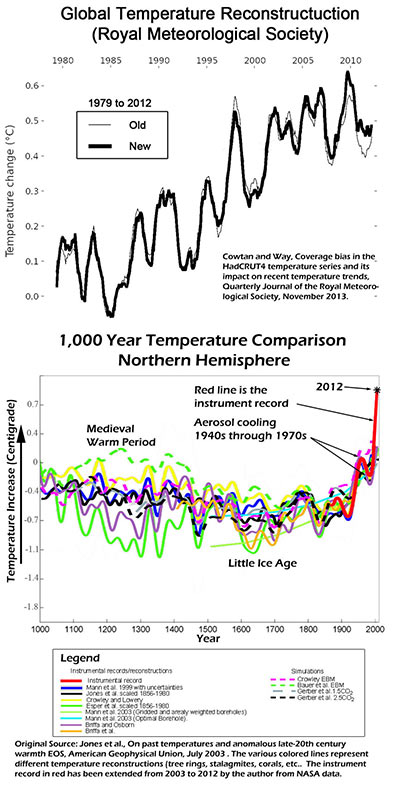 These volunteer scientists also did something they normally don’t do this time. They debunked a climate myth. This is the “temperature flattening myth” that is so present in this perceived debate and that has become so prevalent in our society. Their story goes that earth’s temperature stopped warming in 1998, therefore climate change is not real. In 1998, we had the largest El Nino ever recorded. This massive warming of surface waters in the southern Pacific raised the temperature of Earth in that one year by about 0.15 degrees, or as much as it rose because of global warming in the previous decade.
These volunteer scientists also did something they normally don’t do this time. They debunked a climate myth. This is the “temperature flattening myth” that is so present in this perceived debate and that has become so prevalent in our society. Their story goes that earth’s temperature stopped warming in 1998, therefore climate change is not real. In 1998, we had the largest El Nino ever recorded. This massive warming of surface waters in the southern Pacific raised the temperature of Earth in that one year by about 0.15 degrees, or as much as it rose because of global warming in the previous decade.
The IPCC 2013 prominently sinks this myth as the fifth statement of fact in their Summary for Policy Makers (SPM): “Trends based on short records are very sensitive to the beginning and end dates and do not in general reflect long-term climate trends.” (SPM, Page 3) The mythmakers chose 1998 as the beginning of their myth. This is plain and simple cherry picking. If one looks at the trend beginning in 1997, the temperature rise is anything but flat. If one begins in 1994, the annual rise rivals the fastest rise in the instrumental record from 1976 to 1997.
Since 1998, the global temperature record has been broken three times and tied once. The new IPCC report tells us that half of warming (57%) that should have already occurred has been masked by aerosols mostly emitted since the turn of the century in rapidly developing Asian nations (yes, warming would double if cooling smog pollutants were suddenly cleaned up in Asia). (SPM, Page 9) The new IPCC report also tells us the deep oceans are now warming, whereas before they were not, and 90 percent of actual warming has gone into the oceans (SPM, Page 4).
There is also new work, post IPCC 2013, that shows that warming since the turn of the century has been significantly greater than we thought. The reason is that the United Kingdom’s temperature record simply ignores the Arctic. The Arctic is the most rapidly warming place on Earth, but there are no thermometers there. Using advanced statistics, this new work adds Arctic temperatures back in.
A Brave New Proclamation
The brave new proclamation in the new IPCC report was saved as the next to the last statement of fact in the SPM :”A large fraction of anthropogenic climate change resulting from CO2 emissions is irreversible on a multi-century to millennial time scale, except in the case of a large net removal of CO2 from the atmosphere over a sustained period.” A large “net” removal . . . this means greater than 100 percent annual emissions reductions . . . In other words, we have to take more out than we are putting in every year. We must begin to remove some of the long-lived carbon pollution that we have already placed in our skies. (SPM, E.8, Page 20)
If we would have reduced our emissions to 1987 levels by 2012 – as was suggested prudent by the Kyoto Protocol – that would have been all that was needed. In the last 28 years we have emitted as many greenhouse gas pollutants as we emitted in the previous 236 years. (10) Somehow, we must begin to remove some of the load of long-lived greenhouse gases that have been accumulating in our sky.
Good News: The Solutions are Within our Grasp
The economic evaluations of the solutions to climate change show that 1 percent of global gross domestic product ($540 billion in 2012) is what we need to spend to control climate pollution every year – using existing technologies, techniques and policy.
This $540 billion may sound like a lot, but it’s no more than we spend on either the Clean Water Act or the Clean Air Act in the US every year. It is no more than we spend on the military in the United States every year – not counting wars. It’s twice what we spend disposing of urban garbage across the planet every year. It’s no more than what we lose to normal weather losses and delays every year in the US – not counting climate change enhanced weather extremes. It’s no more than we spend on advertising across the globe every year. It’s only 25 percent of what we spend on health care in the United States every year – before Obamacare.
The scale is large and the amount of work immense, but treating climate pollution is not unlike many other things that have been accomplished across this planet over decades past for amounts of money that are relatively small. Another reference: Exxon Mobile has a market capitalization of $417 billion alone.
Extraordinary Urgency and New Climate Paradigm
Now that I have put you at ease with the simplicity of the solutions, the hard truth is that this global greenhouse gas experiment has gone horribly wrong. There are discoveries that are extraordinarily important to the discussion of appropriate policy and behavior that are unknown by all but a few.
The new paradigm of climate science states that oil is responsible for 2.5 times more warming than coal in short-term climate time frames (20 years or less). The reason is because coal emits an enormous amount of sulfur dioxide when it burns. Sulfur dioxide is a global cooling pollutant – it cools instead of warms.
Up until recently, science has not known much about cooling pollutants and the chemical reactions that take place in the atmosphere and clouds, water vapor and indirect effects. Now we know. We used to only understand global warming gases by their test tube signatures on warming. Now we know these complicated things about how everything behaves in the atmosphere, and when the math is done, oil is responsible for 2.5 times more warming in the short term than coal. The cooling pollutants are short-lived though, so after 20 years, carbon dioxide becomes the king of the warming gases once again.
But it is the short term that is crucial. If we cross an abrupt change threshold in the short term, or an irreversible threshold, our goose is cooked. In the long-term, we are far more likely to be able to develop solutions to mitigate for greenhouse gas warming. But if we fail to control radical climate change in the short term, we are toast.
Abrupt Change
Professor Broeker’s primary focus has been abrupt climate change. From his bio at the Columbia Earth Institute: “The climate system has jumped from one mode of operation to another in the past [warm to cold, cold to warm]. We are trying to understand how the earth’s climate system is engineered, so we can understand what it takes to trigger mode switches. Until we do, we cannot make good predictions about future climate change. . . ” Over the past six or eight hundred thousand years, our climate has almost always changed in radical jumps from one mode to another. In the last 110,000 years, Greenland ice cores show 23 of these events where the average global temperature jumped 9 to 14 degrees globally in time frames of as little as a few decades to as short as a few years.
Then there is the climate lag. It takes 30 or 40 years for greenhouse warming to catch up to atmospheric concentrations of greenhouse gases because of the great capacity of our oceans to cool the planet. This means that today we are operating on atmospheric concentrations of greenhouse gases from the 1970s. In the last 29 years we have emitted as many greenhouse gases as we emitted in the previous 236 years. Because of the great cooling effect of the oceans, we have not yet begun to see the warming that this recent doubling of greenhouse gases will bring.
The Life of Carbon Dioxide
And carbon dioxide lasts a lot longer in the atmosphere than we have understood previously. This is largely because as it warms, less carbon dioxide can dissolve into the oceans or stay in the soils. We once understood that the life of carbon dioxide in our sky was 100 to 200 years. Now we know that 75 percent of CO2 stays in the sky for 300 years and the quarter stays there forever (in relevant time frames of 10,000 years or more).
This is all happening with only a very slight amount of warming and our climate is a long, long way from catching up to greenhouse gas concentrations. Climate change projected by the IPCC 2013 report under the business-as-usual scenario projects warming in the next 80 to 90 years to be bigger than the Paleocene/Eocene Thermal Maximum extinction event 56 million years ago, only changes today are happening 100 times faster than then.
Way More than Climate Weirding
There are many more new climate science discoveries than the IPCC reports. Climate change is and has in the past manifested itself in ways that are completely foreign to mankind’s existence on this planet.
Icequakes appeared in the seismic record for the first time in early 1993, but it took seismologists another decade to determine they were coming from Greenland. They have a different signature from earthquakes, so some sophisticated filtering was required to pinpoint the locations of these quakes. About 184 of them happened between 1993 and 2007 when this research was completed. These icequakes are 1,000 times more powerful than any ice seismic event ever recorded. They register between 4.6 and 5.1 on the Richter scale and can last 30 to 150 seconds. Normal ice seismic events register 2.7 and last only a second or less. There is a time lapse movie of one of these icequakes.
Evidence of climate change-caused Tsunamis a half-mile high (mega tsunamis) was discovered in Hawaii and they happened about 120,000 years ago, when it was only a degree or two warmer than today, in between our last ice age and the one before. They were likely caused as rising sea level destabilized the steep volcanic slopes of the Hawaiian Islands, resulting in mega underwater landslides. Blocks of earth a mile wide moved intact 100 miles across the bottom of the Pacific Ocean. The evidence is earth material stripped away from the sides of the Hawaiian Islands in a way that would not have happened with a landslide, and coral debris deposited in its place.
The Amazon has already flipped from a carbon sink to a carbon source because a 100-year drought in 2005 and another drought in 2010 that was half-again more extreme have killed over 2 billion trees in the Amazon. As a result, the decaying trees are releasing more greenhouse gases than the entire Amazon normally absorbs every year in a nondrought year.
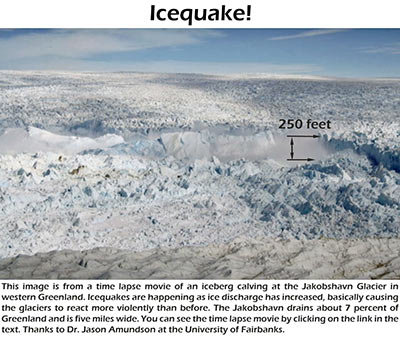 The West Antarctic Ice Sheet collapsed 122,000 years ago, and it is quite likely that we saw 10 to 20 feet of sea-level rise occur in a century to as little as a decade. Separate records from reefs across the world tell us this tale. It happened about the same time as the mega tsunamis in Hawaii and was caused by what are referred to as dynamical ice sheet changes in the 2007 IPCC report.
The West Antarctic Ice Sheet collapsed 122,000 years ago, and it is quite likely that we saw 10 to 20 feet of sea-level rise occur in a century to as little as a decade. Separate records from reefs across the world tell us this tale. It happened about the same time as the mega tsunamis in Hawaii and was caused by what are referred to as dynamical ice sheet changes in the 2007 IPCC report.
However, the IPCC tells us that sea levels will rise only 7 to 23 inches, in its 2007 report, and 14 to 59 inches, in its 2013 report. The IPCC also tells us in its reports that those dynamical ice sheet changes are not considered in their evaluation. The research is there, but it is too new or the scant 100 century old evidence is too tenuous for a consensus process such as the IPCC’s.
IPCC Underestimates: Conservative Consensus Syndrome
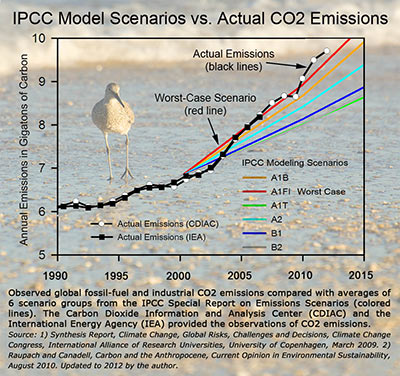 Scientific American tells us very succinctly in the first sentence of a 2012 article how 20 years of IPCC reports underestimate climate change: “Across two decades and thousands of pages of reports, the world’s most authoritative voice on climate science has consistently understated the rate and intensity of climate change and the danger those impacts represent.” A few examples:
Scientific American tells us very succinctly in the first sentence of a 2012 article how 20 years of IPCC reports underestimate climate change: “Across two decades and thousands of pages of reports, the world’s most authoritative voice on climate science has consistently understated the rate and intensity of climate change and the danger those impacts represent.” A few examples:
* Antarctica is losing ice 100 years ahead of schedule. As recently as the 2007 IPCC report, the consensus opinion said that Antarctica would not begin to lose ice until 2100 or later. The recent 2013 IPCC report, however, tells us that not only has Antarctica already started to lose ice, but it has almost caught up with Greenland.
* Arctic sea ice is declining 70 years ahead of schedule as of a record-smashing year in 2007, according to work from the National Snow and Ice Data Center. In 2012, the record-smashing 2007 record was itself smashed by an even greater decline in Arctic sea ice.
* The IPCC predicted an annual sea-level rise of less than 2 millimeters per year in 2001. But over the last 15 years, the oceans have actually risen 3.4 millimeters per year, about 80 percent more than projected.
* Carbon dioxide emissions are worse than the IPCC’s worst-case scenario. Instead of reducing emissions across the planet, total emissions since 1987 have increased 81 percent. In the last 28 years, we emitted as many greenhouse gas pollutants as we had emitted in the previous 236 years.
It’s not just the IPCC that underestimates. Even though global emissions are way up, US carbon dioxide emissions appear to be way down; down 16 percent since the peak in 2007. This would be good, but it’s a mirage. In 2011, 1.5 gigatons of CO2 were offshored in China (mostly) through goods produced there and shipped to the United States. This leaves the United States with an increasing, not decreasing, inventory in 2011. Our emissions have actually increased 11 percent since the “peak” year before the decline began in 2007.
Aerosols from the East Have Cooled the Planet – A LOT!
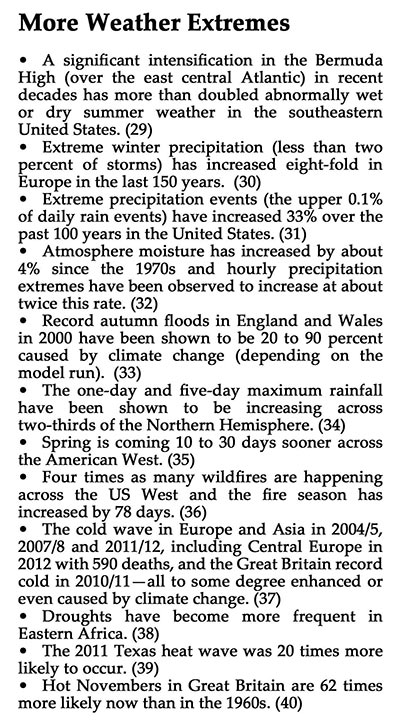 Rapidly developing Asian nations are emitting far more greenhouse gases and other air pollutants than ever before. China just exceeded the US in emissions in 2006. Just six years later in 2012, they are emitting nearly twice as much as the United States (88 percent more). These greenhouse gases are emitted along with other air pollutants like sulfur dioxide. In developing nations, air pollution regulations are not as stringent and a lot more sulfur dioxide is emitted.
Rapidly developing Asian nations are emitting far more greenhouse gases and other air pollutants than ever before. China just exceeded the US in emissions in 2006. Just six years later in 2012, they are emitting nearly twice as much as the United States (88 percent more). These greenhouse gases are emitted along with other air pollutants like sulfur dioxide. In developing nations, air pollution regulations are not as stringent and a lot more sulfur dioxide is emitted.
The sulfur pollutants (aerosols) are cooling pollutants, not warming pollutants like carbon dioxide. The air pollution is so bad in Asia that it is having a global impact on temperature. Remember, the IPCC says that aerosols are masking half of the warming (57%) that we should have experienced. When the masked warming is added back in, global temperature is right at the upper edge of the worst-case scenario, as is carbon dioxide.
Extremes Caused or Enhanced by Climate Change
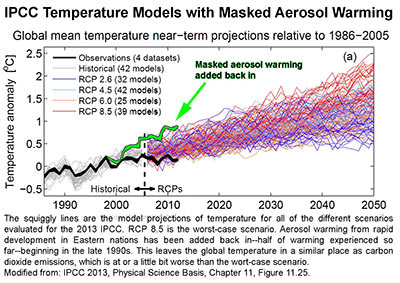 The intensity of climate heat extremes across the Northern Hemisphere has already increased 10 to 100 times since the 1951 to 1981 period. Specifically mentioned in a paper from NASA are the Texas/Oklahoma heat wave of 2011 and the Moscow Heat wave of 2010 that killed 11,000, and we shouldn’t forget the European heat wave of 2003. A European Union Health Program study now shows 70,000 to 80,000 excess deaths beyond what would have occurred normally for that summer.
The intensity of climate heat extremes across the Northern Hemisphere has already increased 10 to 100 times since the 1951 to 1981 period. Specifically mentioned in a paper from NASA are the Texas/Oklahoma heat wave of 2011 and the Moscow Heat wave of 2010 that killed 11,000, and we shouldn’t forget the European heat wave of 2003. A European Union Health Program study now shows 70,000 to 80,000 excess deaths beyond what would have occurred normally for that summer.
Cold weather extremes can even intensify on a warmer planet as the range of volatile weather increases with more energy in the atmosphere. Cold weather extremes in 2009/2010 and 2010/2011 in the eastern United States and Europe, including Snowmeggedon in the Northeast US in 2010, validate modeling that increases these extremes because of Arctic warming.
National Center for Atmospheric Research scientist Kevin Trenberth, two-time lead scientist for the IPCC, has spelled out a fundamental truth when answering the question: “Was this weather event caused by climate change?” His response, published in Climatic Change in March 2012: “All weather events are affected by climate change because the environment in which they occur is warmer and moister than it used to be.”
The Fairness Bias
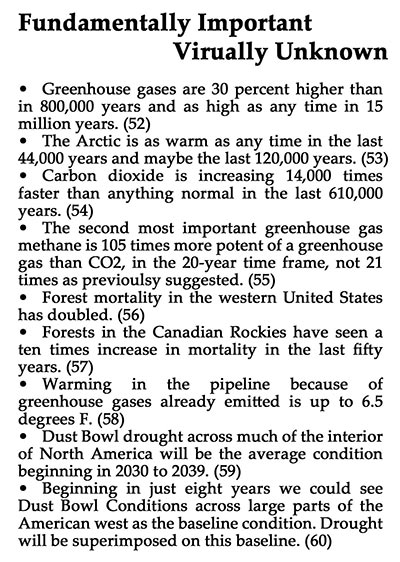 So why in the world is all this stuff not being reported? For one, the public is 20 years behind climate science. In 1990, 60 percent of climate scientists believed in climate change. Today, about 60 percent of the public believes in climate change and 97 percent of climate scientists believe.
So why in the world is all this stuff not being reported? For one, the public is 20 years behind climate science. In 1990, 60 percent of climate scientists believed in climate change. Today, about 60 percent of the public believes in climate change and 97 percent of climate scientists believe.
Even more important is the “fairness bias.” This has been well documented in the literature and it concerns the great perceived debate. The media are not climate scientists and do not know whom to believe. Almost no climate scientists trust the media’s coverage of climate change. Ninety-seven percent of climate scientists say that climate change is real, but the three percent who do not are reported with very loud, well-funded and persistent voices, and the mainstream media reports both sides “fairly.”
This “fairness bias” thing goes back a long way. It’s based in the Fairness Act and the Equal time Act and even the Journalistic Creed. It’s only fair to be fair. It’s a moral thing; give both sides a say. This works great when we are talking about issues. But science is not an “issue.”
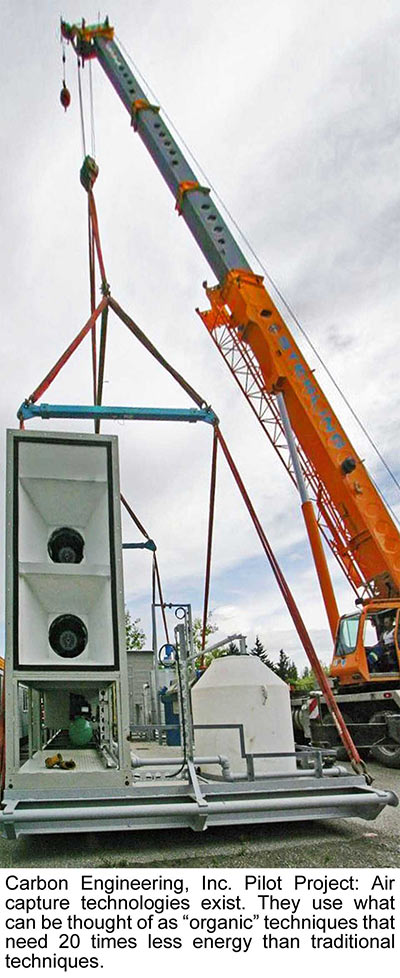 The wealthiest and most powerful industry in the world perceives itself to be at risk of extinction and has invested literally hundreds of millions of dollars in campaigns to discredit climate science (propaganda campaigns). The propaganda created by these industries uses some of the same exact propaganda people and firms as were used in the smoking debate, the acid rain regulations debate and the ozone depleting chemical regulation debate. They take the 3 percent opinion and promote it endlessly, regardless of how many times these few scientists have been disproven in the literature.
The wealthiest and most powerful industry in the world perceives itself to be at risk of extinction and has invested literally hundreds of millions of dollars in campaigns to discredit climate science (propaganda campaigns). The propaganda created by these industries uses some of the same exact propaganda people and firms as were used in the smoking debate, the acid rain regulations debate and the ozone depleting chemical regulation debate. They take the 3 percent opinion and promote it endlessly, regardless of how many times these few scientists have been disproven in the literature.
By giving the 3 percent equal time to the 97 percent, the media bias their reporting. That and maybe they simply don’t understand the scientists’ press releases when they refer to dendrochronologists, oxygen isotopes and precession.
The Scandal of the Scandals
The media has also played a role in furthering the discrediting of climate science because of sensationalistic reporting of supposed climate scandals. The big three:
* Climate Gate Email Scandal: Wording taken out of context in stolen emails was widely reported as proving climate scientists were dishonest in their work. Six independent reviews cleared all scientists involved.
* Himalayan Glaciers: A few errors in tens of thousands of facts are reported in the media ruthlessly, but the reason for the error is not. The 2007 IPCC report said that Himalayan glaciers would melt by 2035. There was a simple Scribner’s error. The date should have been 2350. The error was in a short discussion of Himalayan glaciers in Volume 2 of the report Impacts, Adaptation and Vulnerability. Volume 1, The Physical Science Basis, had a 45-page discussion of global ice that was all correct, including the parts about the Himalaya.
* Amazongate: The United Kingdom’s Sunday Times erroneously posted a story about how badly the 2007 IPCC report misrepresented climate change impacts on the Amazon rainforest that made headlines across the world. Five months later – with almost no press whatsoever – the Times retracted the entire article and published a 400-word apology.
Sky Mining: Really Good News
Broeker, like a few others, has recognized the likelihood that our global society will not be able to end the burning of fossil fuels and strongly advocates, along with emissions reductions, the collection and disposal of climate pollution in very similar ways that we collect and dispose of garbage. We can take it out of coal plant smokestacks, but that is less than half. There is no magic bullet to get the rest from transportation and buildings, and the IPCC says we need to remove more than 100 percent of emissions.
We can do this. But there is an academic hurdle to overcome. Using traditional calculations of the heat required for a chemical reaction to occur, CO2 capture from coal burning power plants works because flue gasses are 10 to 15 percent CO2. The typical air concentration is 0.3 percent or about 33 to 50 times less. When the math is done and the pilot flue gas capture tests are costed, it takes $60 a ton to remove CO2 from flue gas and $500 or more per ton for air capture. (63) This argument is very pervasive in industry. They say you can’t beat physics, so air capture is a bust. While valid, this argument is displaced.
We need to focus on energy generation, not energy (heat) requirements. The flue gas removal process takes about 700 degrees or 1,300 degrees F. The new air capture techniques happen from near-room temperature to less than 100 degrees C. The cost to remove a ton of CO2 from the atmosphere in a full-scale pilot plant is expected to be $200 per ton. Once fully industrialized, it is expected to be $30 per ton.
Broeker puts it this way in his biography Fixing Climate: “If you extract a certain amount of CO2 from the air, you could replace that same amount by burning a fossil fuel without harming the planet.” It takes 170 times more energy to make electricity from the wind as it does from fossil fuels. It is much more efficient to make electricity from coal and then extract carbon dioxide from the wind. Moreover, the new technologies are simply cheaper because they operate at far cooler temperatures.
Sky mining is a promising solution to our climate pollution needs. We took it out of the ground and put it in the sky; now we must take it out of the sky and return it to the ground.
At $200 per ton of CO2, we can remove 50 ppm CO2 from the atmosphere for $21 trillion. This is $13 trillion less than US military and health care spending from 2000 to 2009 ($34 trillion). Worth repeating an endless number of times: Once fully industrialized, the price drops to $20 or $30 per ton.
Because half of the CO2 we emit stays in our sky in time frames that matter, once the new solutions are fully industrialized, we can remove 27 years worth of climate pollution from our sky for what the US spends on health care in less than two years.
This is $3 or $4 trillion to basically fix climate change – remove 50 ppm CO2 from the sky for no more than the cost of a couple of years of health care . . . We might have to do this a few or even several times, but the cost would still be something similar to what the US alone has spent on its military and wars since the turn of the century.
Please tell your friends. To prevent dangerous climate change, we must now convince the public and our leaders to act decisively and robustly. Simple emissions reductions will no longer prevent dangerous climate change.
See also “Climate Change 2013: Where We Are Now,” a detailed reference with critical passages from firewalled papers and additional supplementary information.
5 Days Left: All gifts to Truthout now matched!
From now until the end of the year, all donations to Truthout will be matched dollar for dollar up to $50,000! Thanks to a generous supporter, your one-time gift today will be matched immediately. As well, your monthly donation will be matched for the whole first year, doubling your impact.
We have just 5 days left to raise $50,000 and receive the full match.
This matching gift comes at a critical time. As Trump attempts to silence dissenting voices and oppositional nonprofits, reader support is our best defense against the right-wing agenda.
Help Truthout confront Trump’s fascism in 2026, and have your donation matched now!
